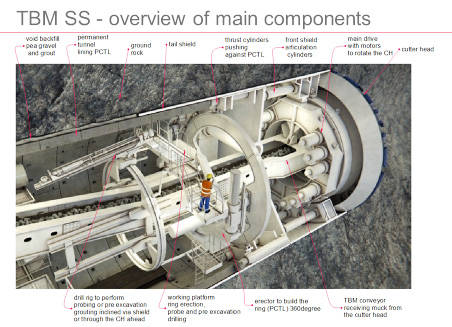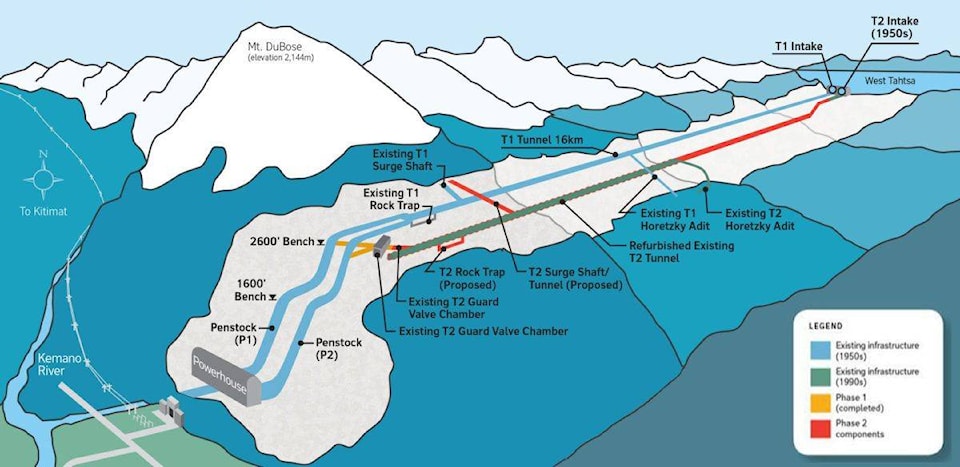The Rio Tinto board has approved the US-$473 million completion of the Kemano Second Tunnel (T2) Project.
Rio Tinto B.C. Works general manager Gareth Manderson said the completion of the nearly 8km stretch of the second tunnel will start in spring of 2018 and is expected to be complete by 2020.
“Completing this tunnel will ensure we have a stable, long-term power supply for the newly modernized Kitimat smelter and that our operations will continue to make a significant contribution to B.C.’s economy over the coming decades,” said Manderson.
“This investment will enhance B.C. Works’ position as a world-leading producer of low carbon aluminium through environmentally sustainable hydropower.”
The second tunnel will create a back-up for the original tunnel that was built over 60 years ago.
“This will allow us to conduct maintenance work without shutting down our operations, ensuring we can continue to responsibly manage the Nechako Watershed reservoir system,” added Manderson.
He stressed that the second tunnel will connect to the existing power station with no new generators being built and that it would not draw any more water than what is currently allocated in the company’s water licence.
B.C. Works communication manager Kevin Dobbin said U.S. construction company Frontier-Kemper Aecon, which has been appointed as the main contractor to deliver the majority of the construction scope, will also be responsible for hiring subcontractors and employees.
He said civil, building and specialty construction company Tutor Perini Corporation will complete the construction of the remaining 7.6-km section, as well as refurbish the existing 8.4km of the 16-km second tunnel at the Kemano power plant, as part of a joint venture between its subsidiary, Frontier-Kemper Constructors, and Aecon Group Inc., of which Frontier-Kemper has a 60 per cent share.
“The main contractor’s scope of work includes the excavation and boring of new tunnel segments, tunnel lining, rehabilitation of existing underground and surface excavations, and installation of intake gates and other related structures,” said Dobbin.
He said the refurbishment work on the existing T2 downstream tunnel will start in the second quarter of 2018, as will site activities to open up existing access roads and the establishment of a camp.
The T2 downstream work also includes some drilling and blasting (400m) as part of putting in a surge tunnel (a structure which compensates for the pressure created by the water hammering effect in a tunnel).
“Some minor work at the existing T2 intake will also be completed during the summer of 2019. The current schedule is to have the total project completed before the end of 2020,” said Dobbin.
The tunnel boring machine (TBM) that will complete the last 7.6km of the tunnel is being specially designed in Germany and will take up to a year to engineer and fabricate before it is shipped to site.
The TBM is expected to arrive by barge from Germany in the fall of 2018 and will be assembled at the site. Drilling is anticipated to begin in the winter of 2018. The rock spoil will be deposited at the existing Horetzky landing site that was previously used in the 1990’s during the construction of the first part of the second tunnel.
“All permits and licences are in place for the material to be placed in a controlled way,” added Dobbin.
During the peak summer construction periods the project will employ approximately 350 workers.
“While much of the work will be highly specialized, Frontier-Kemper Aecon will ensure First Nations and local and regional businesses that are competitive and meet requirements, will have the opportunity to be involved,” said Dobbin.
He said the ratio of local workers versus specialized workers won’t be known until the project begins.
The workforce will be based out of a camp located at Kemano (a 140 person camp is already in place) and in a camp at the Horetzky landing (situated above ground halfway along the tunnel). This camp will accommodate up to 200 workers and will be put in place in the spring of 2018.
“No accommodation is required in Kitimat for the project,” said Dobbin.
Crews will travel to and from Kemano by boat and remain accommodated at the Kemano camp on a 14-day on/7-day off shift rotation, with drilling occurring day and night.

